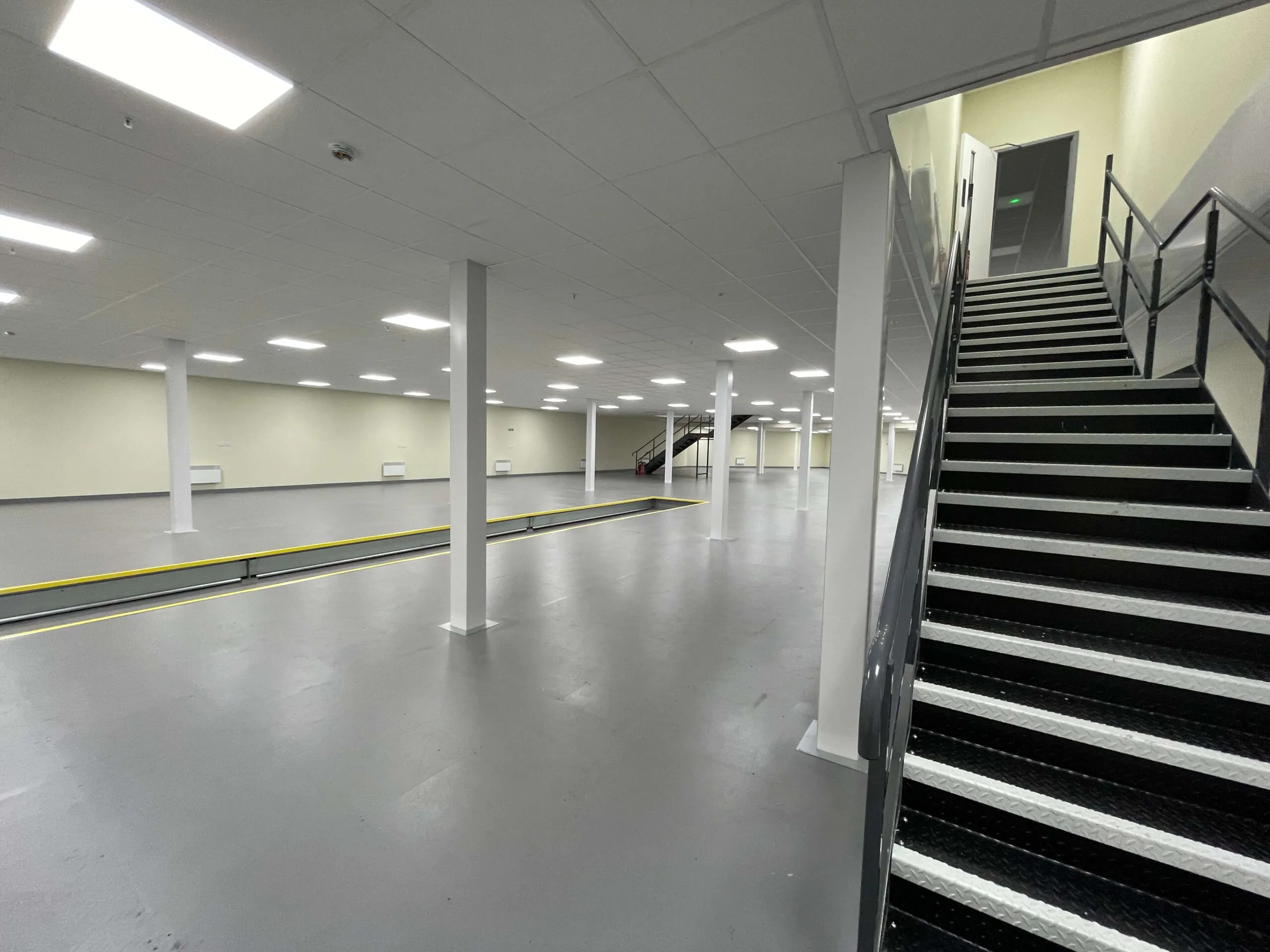Are you feeling the squeeze in your warehouse or factory? Before you consider the costly option of relocating or expanding your building, explore the potential of industrial mezzanine floors! These innovative platforms can unlock valuable vertical space, effectively multiplying your storage capacity, streamlining your workflow, and maximizing every square foot. This comprehensive guide will equip you with the knowledge and insights to determine if an industrial mezzanine floor is the right solution for your business needs.
Industrial Mezzanine Floors: A Versatile Solution
Imagine adding an entirely new level to your existing space without the expense and disruption of a major construction project – that’s the magic of industrial mezzanine floors! These versatile structures seamlessly integrate into your existing layout, providing a multitude of benefits and adapting to your specific requirements.
Why Choose a Mezzanine Floor?
In the competitive business landscape, space equates to profitability. Industrial mezzanine floors are the ultimate tool for maximizing your existing square footage, offering a range of advantages:
- Double Your Space: Instantly expand your usable area without the need for costly expansions or relocations.
- Boost Efficiency: Streamline workflows, reduce unnecessary movement, and optimize your layout for enhanced productivity.
- Tailor-Made Solutions: From lightweight storage to heavy-duty machinery support, mezzanine floors are engineered to meet your specific load and functionality requirements.
Planning Your Mezzanine Floor: Key Considerations
Before diving headfirst into a mezzanine floor project, careful planning is essential. Consider these crucial factors to ensure a successful and efficient implementation:
- Load Capacity: Determine the maximum weight your mezzanine needs to support, factoring in the weight of the floor itself, equipment, materials, and personnel. A qualified structural engineer can assess your needs and design a safe and robust structure.
- Load Distribution: Evenly distribute the weight across the mezzanine floor to prevent overloading and potential hazards. Consider column spacing and point loads to ensure structural integrity.
- Access Points: Strategically plan access points, including stairs, ladders, gates, or even freight elevators, to ensure safe and efficient movement of people and materials to and from the mezzanine level.
Types of Industrial Mezzanine Floors
Just as no two businesses are alike, industrial mezzanine floors come in various configurations to suit different needs and applications. Let’s explore the most common types:
- Freestanding Mezzanines: As the name suggests, these self-supporting structures don’t rely on existing building components for support. This makes them ideal for businesses that value flexibility and may need to rearrange their layout in the future.
- Rack-Supported Mezzanines: Designed to maximize storage capacity, these mezzanines are integrated with existing pallet racking systems or mounted directly onto them, effectively creating a two-story storage solution.
- Catwalk Mezzanines: These elevated walkways provide safe and convenient access to machinery, equipment, or different areas within your facility. They’re particularly useful in large warehouses or manufacturing plants where easy access is crucial.
- Full Mat Mezzanines: Covering the entire floor area beneath them, full mat mezzanines provide a continuous, solid platform ideal for maximizing storage space over shelving units or creating a dedicated workspace.
Choosing the Right Mezzanine: Factors to Consider
Selecting the optimal mezzanine floor configuration for your business requires careful consideration of your specific requirements:
- Load Capacity: Different mezzanine types offer varying load capacities. Determine the weight your mezzanine needs to support, including live loads (people, equipment, materials) and dead loads (the weight of the structure itself).
- Height: Available vertical space is crucial. Consider the required clearance beneath the mezzanine for equipment, machinery, or personnel.
- Layout: Design a mezzanine layout that aligns with your workflow and optimizes space utilization. Consider factors like aisle width, work cell placement, and access points.
- Access: Choose appropriate access points, such as stairs, ladders, or gates, based on factors like frequency of use, safety regulations, and the type of materials being moved.
Industrial Mezzanine Applications: A Versatile Solution
The versatility of industrial mezzanine floors makes them suitable for various industries and applications:
- Manufacturing: Create dedicated assembly areas, optimize production flow by housing bulky machinery above, or add office space without sacrificing valuable floor space.
- Warehousing: Expand storage capacity, optimize picking and packing processes, or even incorporate in-house office space for increased efficiency.
- Retail: Utilize a mezzanine level for eye-catching product displays while using the space below as a sales floor or stockroom.
Industrial Mezzanine Floor Costs: Factors & Considerations
Adding an industrial mezzanine floor is a cost-effective way to expand your workspace without the expense of moving or building an extension. However, several factors influence the overall cost:
- Size: As with any construction project, larger mezzanine floors require more materials and labor, resulting in a higher price tag.
- Design Complexity: Simple, rectangular designs are generally more affordable than complex layouts with curves or multiple levels.
- Customization: Additional features, such as custom lighting, heavy-duty ventilation, or specialized access points, will increase the overall cost.
- Safety Requirements: Compliance with building codes and safety regulations might necessitate specific materials or construction methods that can impact the price.
Budget-Friendly Strategies
- Modular Designs: Opt for prefabricated, modular mezzanine systems for faster installation and reduced labor costs.
- Natural Lighting: Maximize natural light to minimize the need for artificial lighting and reduce energy consumption.
- Existing Structures: Leverage existing structural elements to potentially reduce the need for additional support columns, saving on materials.
In the UK, the average cost for a standard industrial mezzanine floor is around £100 per square meter. Remember that this is just an estimate, and your specific needs and preferences will influence the final price.
Industrial Mezzanine Floor Design: Key Considerations & Best Practices
Designing an effective and efficient industrial mezzanine floor goes beyond simply adding an extra platform. Consider these key aspects:
- Space Optimization: Mezzanine floors are champions of maximizing existing space. Carefully plan the layout to accommodate storage, workstations, or any other functional areas you require.
- Structural Integrity: The foundation of your mezzanine’s safety and functionality lies in its structural integrity. Factors like slab thickness, load-bearing capacity, and the spacing of support columns are crucial to ensuring a secure and reliable structure. Consult with a qualified industrial engineer to ensure your mezzanine meets all safety standards.
- Style and Materials: Industrial mezzanine floors are available in various styles and materials to suit your aesthetic preferences and functional requirements. Popular choices include steel and aluminum for their durability and sleek appearance. Choose a style that aligns with your brand identity and complements your existing workspace.
The Importance of Professional Expertise
Designing a mezzanine floor is a complex undertaking. Enlisting the help of experienced industrial engineers is highly recommended. These professionals can guide you through the entire process, ensuring your mezzanine floor meets all safety regulations, aligns with your specific needs, and integrates seamlessly with your existing infrastructure.
Additional Considerations:
- Energy Efficiency: Mezzanine floors can contribute to energy savings by reducing the need for lighting and heating in the overall space.
- Automation: Integrate your mezzanine design with existing or planned automated systems, such as conveyor belts or robotic systems, for enhanced productivity and workflow optimization.
- Customization: Explore options for customizing your mezzanine with features like non-slip flooring, modular designs for future adaptability, or specific finishes to enhance its functionality and aesthetics.
Conclusion
An industrial mezzanine floor is a significant investment that can yield substantial returns in terms of increased space, enhanced efficiency, and improved workflow. Thorough planning, careful consideration of your specific needs, and professional guidance are essential for a successful mezzanine floor project.
For more insights and information, explore the following resources:
- Mezzanine Flooring: [https://www.wavesold.com/mezzanine-flooring]
- Mezzanine Floor Height: [https://www.wavesold.com/mazzenine-floor-height]
- Open Mezzanine Floor in Residential Energy Modelling: [https://www.wavesold.com/how-to-treat-open-mezzanine-floor-in-residential-energy-modelling]
- Mezzanine Floor Systems in the United States: [https://www.wavesold.com/mezzanine-floor-system-about-united-states]
By investing in a well-designed and expertly installed industrial mezzanine floor, you’re not just adding space – you’re investing in the future success and growth of your business.
- White Kitchen With Butcher Block Countertops: A Warm, Inviting Design - January 4, 2026
- Marble Countertops Prices: What Impacts the Overall Cost to Install? - January 3, 2026
- Marble Countertops Cost: What Factors Impact the Total Price? - January 2, 2026










